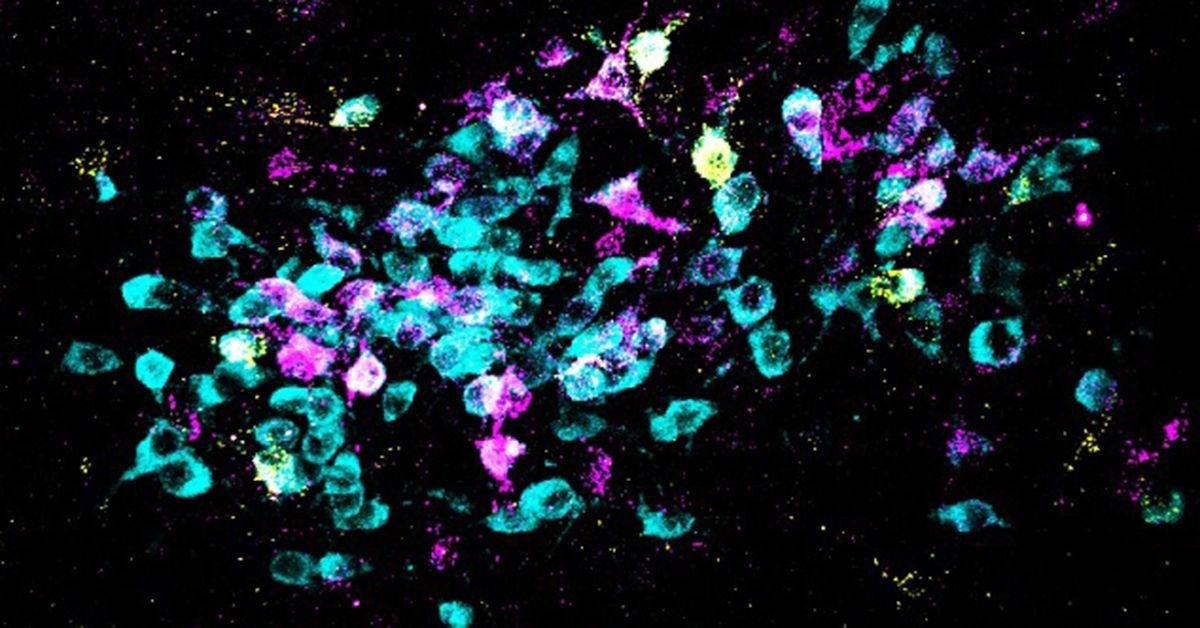Neurobiologists have discovered how stress causes the brain to become fearful in situations like Post-Traumatic Stress Disorder (PTSD) and how to stop it.
 New research published in Science identifies the brain biochemistry and neural circuitry that cause generalized fear experiences. Here, neurons are shown in cyan and retrograde tracers shown in yellow and magenta. Image Credit: Spitzer Lab, UC San Diego
New research published in Science identifies the brain biochemistry and neural circuitry that cause generalized fear experiences. Here, neurons are shown in cyan and retrograde tracers shown in yellow and magenta. Image Credit: Spitzer Lab, UC San Diego
Fear is a natural sensation for the nervous system. The fear response is a survival mechanism that alerts humans to stay vigilant and steer clear of dangerous situations, regardless of what triggers it - odd noises in the dark or the growl of an approaching threatening animal.
It can be detrimental to the wellbeing, though, if fear materializes in the absence of real threats. After experiencing periods of extreme or potentially fatal stress, individuals may go on to feel fearful even in situations where there is no genuine threat. It is psychologically harmful to experience this generalization of fear, and it can lead to crippling long-term mental health conditions like post-traumatic stress disorder (PTSD).
Most of the time, it has been unclear what stress-induced mechanisms trigger the brain to create feelings of fear when there are no external threats. Researchers studying neurobiology at the University of California, San Diego, have now pinpointed the biochemical alterations in the brain as well as the neural circuitry responsible for this type of widespread fear response. Their work offers fresh perspectives on how fear reactions might be avoided and was published in the journal Science on March 15th, 2024.
Atkinson Family Distinguished Professor Nick Spitzer of the School of Biological Sciences, former UC San Diego Assistant Project Scientist Hui-quan Li (now a Senior Scientist at Neurocrine Biosciences), and their colleagues describe in their report the research behind their discovery of the neurotransmitters—the chemical messengers that allow the brain's neurons to communicate with one another—at the root of stress-induced generalized fear.
Researchers found that acute stress caused a change in the chemical signals in the neurons, switching from excitatory “glutamate” to inhibitory “GABA” neurotransmitters, which resulted in generalized fear responses. This change was observed in the brains of mice in an area known as the dorsal raphe (located in the brainstem).
Our results provide important insights into the mechanisms involved in fear generalization. The benefit of understanding these processes at this level of molecular detail - what is going on and where it’s going on - allows an intervention that is specific to the mechanism that drives related disorders.”
Nick Spitzer, Professor, Department of Neurobiology, University of California San Diego
Nick Spitzer is also associated with the Kavli Institute for Brain and Mind.
Building on this recent discovery of a stress-induced neurotransmitter switch, which is thought to be a type of brain plasticity, the researchers next looked at the postmortem human brains of PTSD sufferers. Their brains' confirmed glutamate-to-GABA neurotransmitter switch was similar.
The scientists then discovered a means of inhibiting the generation of broad-based fear. They used an adeno-associated virus (AAV) injection to suppress the GABA synthesis gene in the mice’s dorsal raphe before they experienced acute stress. This technique stopped the mice from developing a fear that was widespread.
Furthermore, the transmitter switch and subsequent onset of generalized fear were avoided in mice treated with the antidepressant fluoxetine (marketed as Prozac) right after a stressful event.
The researchers not only located the neurons that changed their transmitter, but they also showed how these neurons were connected to the lateral hypothalamus and central amygdala, two areas of the brain that have previously been connected to the production of different fear responses.
Now that we have a handle on the core of the mechanism by which stress-induced fear happens and the circuitry that implements this fear, interventions can be targeted and specific.”
Nick Spitzer, Professor, Department of Neurobiology, University of California San Diego
Source:
Journal reference:
Li, H., et al. (2024) Generalized fear after acute stress is caused by change in neuronal cotransmitter identity. Science. doi.org/10.1126/science.adj5996